|
|
|
Sort Order |
|
|
|
Items / Page
|
|
|
|
|
|
|
| Srl | Item |
| 1 |
ID:
150353


|
|
|
|
|
| Summary/Abstract |
China is vigorously promoting the development of its unconventional gas resources because natural gas is viewed as a lower-carbon energy source and because China has relatively little conventional natural gas supply. In this paper, we first evaluate how much unconventional gas might be available based on an analysis of technically recoverable resources for three types of unconventional gas resources: shale gas, coalbed methane and tight gas. We then develop three alternative scenarios of how this extraction might proceed, using the Geologic Resources Supply Demand Model. Based on our analysis, the medium scenario, which we would consider to be our best estimate, shows a resource peak of 176.1 billion cubic meters (bcm) in 2068. Depending on economic conditions and advance in extraction techniques, production could vary greatly from this. If economic conditions are adverse, unconventional natural gas production could perhaps be as low as 70.1 bcm, peaking in 2021. Under the extremely optimistic assumption that all of the resources that appear to be technologically available can actually be recovered, unconventional production could amount to as much as 469.7 bcm, with peak production in 2069. Even if this high scenario is achieved, China’s total gas production will only be sufficient to meet China’s lowest demand forecast. If production instead matches our best estimate, significant amounts of natural gas imports are likely to be needed.
|
|
|
|
|
|
|
|
|
|
|
|
|
|
|
|
| 2 |
ID:
150382


|
|
|
|
|
| Summary/Abstract |
The deep economic crisis and the sharp rise in electricity prices have reduced electricity demand by Spanish households. This paper aims to analyse the responsiveness of household electricity demand and the welfare effects related to both factors in the 2006–2012 period by applying a demand model estimated with the quantile regression method. The results show that the electricity consumption of medium-high income households is particularly responsive to price increases, whereas that of medium-low income households is more responsive to changes in income. The retail electricity price increases and the economic crisis have led to lower and steeper U-shape price elasticities of demand and higher and steeper N-shape income elasticities of demand. The joint impact of those two factors on the welfare of lower-income households is higher in relative terms (i.e., as a share of household income) than for other income groups. These results suggest that the economic crisis and increases in retail electricity prices have had detrimental welfare effects, especially on the lower-income segment of the population. They should be considered when financing climate and energy policies through the electricity bill and provide a rationale to take such support, which pushes the retail electricity price upwards, out of the electricity bill.
|
|
|
|
|
|
|
|
|
|
|
|
|
|
|
|
| 3 |
ID:
150378


|
|
|
|
|
| Summary/Abstract |
This study explored the key factors underlying people's anti-nuclear behavioral intentions. The protective action decision model and the heuristic–systematic model were integrated and adapted from a risk information perspective to construct a hypothetical model. A questionnaire study was conducted on a sample of residents near the Haiyang Nuclear Power Plant, which is under construction in Shandong Province, China (N=487). Results show that, as expected, perceived knowledge is vital in predicting people's information insufficiency, information seeking, systematic processing, and risk perception. Moreover, the inverted U relationship between perceived knowledge and anti-nuclear behavioral intentions is indicated in the study. Information insufficiency and information seeking also significantly predict systematic processing. Furthermore, people's behavioral intentions are motivated by risk perception but fail to be stimulated by systematic processing. Implications and recommendations for future research are discussed.
|
|
|
|
|
|
|
|
|
|
|
|
|
|
|
|
| 4 |
ID:
150398


|
|
|
|
|
| Summary/Abstract |
This paper examines the integration properties of the total oil consumption in 57 countries for the period of 1965–2012. A combination of new and powerful linear and nonlinear stationarity tests are employed to achieve the objectives of the study. We find that the oil consumption series in 21 countries follow a nonlinearity path while those in the other countries are linear in nature. Evidence of the presence of a unit root is found for the total oil consumption series in 38 countries while the series is stationary in the remaining 19 countries. An important insight is that the blueprints that were designed to reduce oil consumption are likely to have a permanent effect in most of the countries.
|
|
|
|
|
|
|
|
|
|
|
|
|
|
|
|
| 5 |
ID:
150380


|
|
|
|
|
| Summary/Abstract |
Implementing energy conservation initiatives within public schools, including both behavioral changes as well as building retrofits, can generate cost saving and educational benefits. However, the level of energy efficiency improvements that can be achieved may depend on the socio-economic characteristics of the school or the underlying district. The purpose of this research is to identify and examine the factors that have a role in influencing the adoption of energy-saving practices and/or building retrofits within Oklahoma’s public schools. In order to investigate these factors, a survey was administered to public school administrators across the state. The results illustrate different factors that drive schools to make decisions associated with energy conservation and retrofitting efforts. A comparative analysis between different types of schools (e.g., rural vs. urban, low- vs. high-income) was also conducted to discover the combination of characteristics that are associated with energy-saving measures. The findings could help school administrators and teachers understand how they might adopt new behaviors or technologies.
|
|
|
|
|
|
|
|
|
|
|
|
|
|
|
|
| 6 |
ID:
150351


|
|
|
|
|
| Summary/Abstract |
In this study we aim at assessing the potential of European regions to solar power generation and its comparison with recent European Union (EU) incentives for the development of this renewable energy source. In this study we use a multi-criteria assessment (MCA) supported by Geographical Information System (GIS) to combine already existing information on solar radiation with other geographical factors such as slope, land use, urban extent and population distribution, as well as proximity to the power grid to generate a suitability map for photovoltaic (PV) power plants across the EU at high spatial resolution. A validation exercise showed that the resulting suitability map is a good predictor of appropriate locations for the deployment of PV power plants. The suitability map was in addition compared to the regional distribution of European funds for development of solar energy from the EU Cohesion policy (2007–2013 programme). Regions were classified according their overall suitability for solar energy power systems and the allocated solar investments by the EU Cohesion policy. This analysis allowed to identify potential mismatches between fund allocations and actual regional suitability for solar energy. It is recommended that future fund allocations take into account suitability criteria for solar energy for optimised results of public policies.
|
|
|
|
|
|
|
|
|
|
|
|
|
|
|
|
| 7 |
ID:
150387


|
|
|
|
|
| Summary/Abstract |
The attention of policy makers on aviation environmental impacts has increased meaningfully over the last years. In order to limit the CO2 emissions in the transport sector, the EU has decided to include the aviation industry in the European Union Emission Trading Scheme (EU-ETS), from 1st January 2012 with the Directive 101/2008/EC.
|
|
|
|
|
|
|
|
|
|
|
|
|
|
|
|
| 8 |
ID:
150358
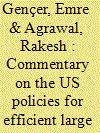

|
|
|
|
|
| Summary/Abstract |
The inevitable depletion of fossil resources and increasing atmospheric greenhouse gas concentrations demonstrate the need for renewable energy conversion technologies for a sustainable economy. Intermittencies and variability in availability of renewable energy sources are the challenges for uninterrupted energy supply, which can be overcome by large scale energy storage facilities. Pumped hydroelectric energy storage is an efficient but a very low energy density energy storage method that dominates the current energy storage market with ~96% share. We first present a recently developed potential solution for large scale efficient and dense energy storage: closed loop carbon storage cycles and a specific example dimethyl ether storage cycle. We then discuss the relevant US energy storage regulations, policy initiatives, their status, and potential modifications that will contribute to the invention and implementation of novel energy storage systems.
|
|
|
|
|
|
|
|
|
|
|
|
|
|
|
|
| 9 |
ID:
150362


|
|
|
|
|
| Summary/Abstract |
The energy efficiency of existing commercial buildings is more challenging to regulate and improve than the energy efficiency of new constructions. In 2011 and 2012, the Chinese Government selected four cities- Shanghai, Tianjin, Shenzhen, and Chongqing- to implement pilot commercial building energy efficiency retrofit program. Based on site surveys and expert interviews in these pilot cities, this research conducted a comparative analysis on incentive policies of local city level. The analysis results show that policy designs of existing commercial buildings should be further improved. The aspects that influence the implementation effect in the future, such as subsidy level, installments, and business model promotion, should be specified in the policy clauses. Referring to the technical solution and cost-benefit in Chongqing, we found that lighting system is the most common retrofit objects while envelope system is the least common one. And the subsidy incentive is greatest for educational buildings, followed by office buildings. In the end, we further discussed the problems and obstacles in commercial building retrofit market, and provided a series of recommendations.
|
|
|
|
|
|
|
|
|
|
|
|
|
|
|
|
| 10 |
ID:
150376


|
|
|
|
|
| Summary/Abstract |
China has become the largest energy consumer worldwide, and it is important to study the energy intensity to realize the sustainable development goal of China. This paper focuses on investigating the influential factors of China's energy intensity using provincial-level panel data from 1985 to 2012. More specifically, we try to identify which factor is relatively more important to pay attention to. A novel approach based on evolutionary computation is proposed to intelligently mine the intrinsic relations between observed phenomena and to let the important factors automatically emerge from the discovered nonlinear models. However, due to China's vast territory and significant heterogeneities, this approach may fail to examine some detailed or hidden information when analyzing the country as a whole. Instead, we concentrate on the provincial level because the provinces play vital roles in reducing energy intensity in China. From our analytical results, the main findings are as follows: (1) the Total Population is the most important influential factor across China's provinces, while the Energy Price Index has the least impact; and (2) the provinces could be naturally classified into four categories based on the primary factors emerged from data, and such classification could reveal more about the true underlying features of each area.
|
|
|
|
|
|
|
|
|
|
|
|
|
|
|
|
| 11 |
ID:
150377
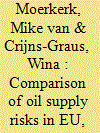

|
|
|
|
|
| Summary/Abstract |
For many countries, the inflow of energy is essential to keep economies running. Oil is typically considered to be the most critical fuel as an input for the petro-chemical and transportation sector and due to limited and less spread reserves. In this study external oil supply risks are assessed for the period up to 2035 for the European Union, United States, China, Japan and India (being the five largest importers of oil in the world), based on their current supplier portfolio. Scenarios are constructed for several climate policy and oil-supply projections.
It is found that risks increase strongly, when stringent climate policies are prevented from being implemented, especially when a peak in oil supply is taken into account, resulting in major oil supply-disruptions. China faces the lowest oil supply risks in most scenarios but the trends of India, China and US converge over time due to increasing import dependency of China and India. Japan faces high risks since the country has the highest oil import dependency combined with a low oil import diversification. For the EU, all figures are strongly influenced by Russia, accounting for 32% of total imports, and to a lesser extent Norway (11%), with high overall risks.
|
|
|
|
|
|
|
|
|
|
|
|
|
|
|
|
| 12 |
ID:
150374
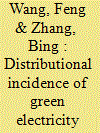

|
|
|
|
|
| Summary/Abstract |
Distributional incidences are fundamental to environmental and energy policies, a condition that has led to controversies on the equity of environmental and energy policy. Using data from China's Urban Household Income and Expenditure Survey data from 2007, this study quantified the distributional effects of the green electricity price subsidy policy among Chinese urban household and compared its effects by using lifetime income and annual income to classify households, respectively. The results show that total electricity subsidies are mainly driven by indirect electricity subsidies. By using lifetime income to classify households, subsidies to households in the poorest two groups accounted for less than 10.2% of the total subsidies, whereas money distributed to households in the top two deciles reached 35.4%. The comparison using annual income to group households also demonstrated the similar impact of the green electricity price subsidy policy. China’s future market reforms should allow electricity prices to reflect pollution abatement costs. Additionally, a multi-step block electricity price schedule can reduce the regressivity of the policy.
|
|
|
|
|
|
|
|
|
|
|
|
|
|
|
|
| 13 |
ID:
150349


|
|
|
|
|
| Summary/Abstract |
In the US, the shale gas revolution ensured that the development costs of unconventional natural gas plummeted to the levels of $2–3/Mcf. This success has motivated the development of shale gas in other regions, including Australia and Europe. This study, focussing primarily on aspects of economic impact analysis, estimates the development costs of shale gas extraction in both Australia and Europe, based on both direct and fiscal costs, and also suggests policy initiatives.
|
|
|
|
|
|
|
|
|
|
|
|
|
|
|
|
| 14 |
ID:
150395


|
|
|
|
|
| Summary/Abstract |
This paper aims to investigate the cost efficiency of South Korea’s district heating (DH) system by using a variable cost function and cost-share equation. We employ a seemingly unrelated regression model, with quarterly time-series data from the Korea District Heating Corporation (KDHC)—a public utility that covers about 59% of the DH system market in South Korea—over the 1987–2011 period. The explanatory variables are price of labor, price of material, capital cost, and production level. The results indicate that economies of scale are present and statistically significant. Thus, expansion of its DH business would allow KDHC to obtain substantial economies of scale. According to our forecasts vis-à-vis scale economies, the KDHC will enjoy cost efficiency for some time yet. To ensure a socially efficient supply of DH, it is recommended that the KDHC expand its business proactively. With regard to informing policy or regulations, our empirical results could play a significant role in decision-making processes.
|
|
|
|
|
|
|
|
|
|
|
|
|
|
|
|
| 15 |
ID:
150341
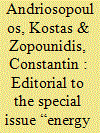

|
|
|
| 16 |
ID:
150399
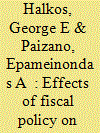

|
|
|
|
|
| Summary/Abstract |
This paper examines the effects of fiscal policy on CO2 emissions using Vector Autoregressions on U.S. quarterly data from 1973 to 2013. In particular, we analyze the short- and mid-term interactions between fiscal policy and emissions by using sign restrictions to identify the policy shocks. We construct the impulse responses to linear combinations of fiscal shocks, corresponding to the scenarios of deficit-financed spending and deficit-financed tax-cuts. To consider possible variations of the effect of fiscal policy according to the sources of pollution, we distinguish between production- and consumption- generated CO2 emissions. The results point out that the implementation of expansionary fiscal spending provides an alleviating effect on emissions from both sources of the pollutant, whereas deficit-financed tax-cuts are associated with an increase on consumption-generated CO2 emissions. The exact pattern of the effects depends on the source of emissions, the scenario of fiscal policy that is implemented and the functional class of government expenditure being increased.
|
|
|
|
|
|
|
|
|
|
|
|
|
|
|
|
| 17 |
ID:
150396


|
|
|
|
|
| Summary/Abstract |
In Italy, the cost of support for renewable electricity (RES-E) is largely recovered through the “A3 surcharge”, which weighs heavily on electricity bills. Using household survey data, we show the A3 surcharge is markedly regressive. Carbon taxation in the non-ETS sector is envisaged as a means to reduce CO2 emissions cost-effectively and generate revenue to lower the A3 surcharge. A non-ETS carbon tax would be less regressive than the A3 surcharge and its cost would be more evenly distributed across households. We calculate the revenue of a €20/tCO2 non-ETS carbon tax would have allowed a cut in the A3 surcharge of about 68% in 2011, and 39% in 2012. The impact of the carbon tax plus the reduced A3 surcharge would have been less regressive, but the cost higher for most households. The restrictions imposed in the simulations mean the results are only appropriate to render first-round effects of the reform.
|
|
|
|
|
|
|
|
|
|
|
|
|
|
|
|
| 18 |
ID:
150364


|
|
|
|
|
| Summary/Abstract |
This paper explores the main legal Center enforced Commissions and Acts that are aimed at improving the current energy deficit in the country, with a specific emphasis on the need for research and a shift in the power market towards more sustainable technology. The paper first examines the main aims of the governmental 5 year plans in the past ten years, and then evaluates the merits and short comings of the existing technical framework that governs the Electrical Grid and Generation systems in the country. The paper also proposes inherent improvements, with ground scale methods in developing a sound and competitive system for power distribution through consumer and employee involvement as well as changes in the investment arena that can substantially alter the market compatibility of renewably generated energy. The paper indicates several key steps that the Center and State Governments have taken in order to revolutionise the feasibility of the electrical systems in the country. Finally, the paper appraises and assesses the main amendments in the Electrical Industry Legal literature and enforcement mechanisms that can effectuate rapid and systemic changes across the Indian context.
|
|
|
|
|
|
|
|
|
|
|
|
|
|
|
|
| 19 |
ID:
150359


|
|
|
|
|
| Summary/Abstract |
We present forecasts of the energy consumption of Morocco towards 2030. Two models have been developed and their results compared: one based on the energy intensity (IE) and another one on a link with the country urbanization rate (URB). The IE model allowed to segment energy consumption in four posts while the URB model only in two posts. For the sensitivity analysis to economic growth, three future GDP evolution scenarios are proposed. The retrospective correlations of both models are excellent but their future extrapolations finish in slightly different results. Through their correlation to electricity consumption, peak power forecasts are also presented. A forecast of the country energy intensity is commented. As the average yearly increase of electricity should still be between 4.9% and 7.1% during 2020–2030, the electric equipment program continuation after 2020 must soon be clarified and avoid the former implementation delays. As the white combustibles needs should yearly increase between 6.3% and 7.8% in 2020–2030, electrical equipment programs should also make provisions for the case of deployment of electric cars. Butane subsidies widen the gap with other fuels and must be removed very soon possible to reduce the growth of its consumption and energy intensity.
|
|
|
|
|
|
|
|
|
|
|
|
|
|
|
|
| 20 |
ID:
150392


|
|
|
|
|
| Summary/Abstract |
South Africa and specifically its economically dominant province of Gauteng aim to reduce their influence on climate change. Especially the transport sector is seen as one of the key drivers of future greenhouse gas (GHG) emissions. This paper describes the methodology used to combine the application of two models in order to provide a basis for informed policy recommendation for GHG mitigation.
The TEMT model provides real world emission factors adapted to local conditions in Gauteng for numerous vehicle technology concepts. Those data feed into the TIMES-GEECO energy system model which identifies future technology use for different alternative scenarios. Finally, the scenario results are illustrated spatially using a GIS programme.
The results of the scenario analysis show that under implemented policies GHG emissions in Gauteng are likely to increase substantially. Pollutant emissions are currently high as a result of a comparably old vehicle fleet. The spatial display of these results shows where the traffic network is concentrated and the location of so-called emission hot-spots. Energy efficient policies for the transport sector of Gauteng can achieve a significant reduction of emissions and energy consumption. Alternative powertrains and the use of locally produced biofuels can play a significant role in such policies.
|
|
|
|
|
|
|
|
|
|
|
|
|
|
|
|
|
|
|
|
|